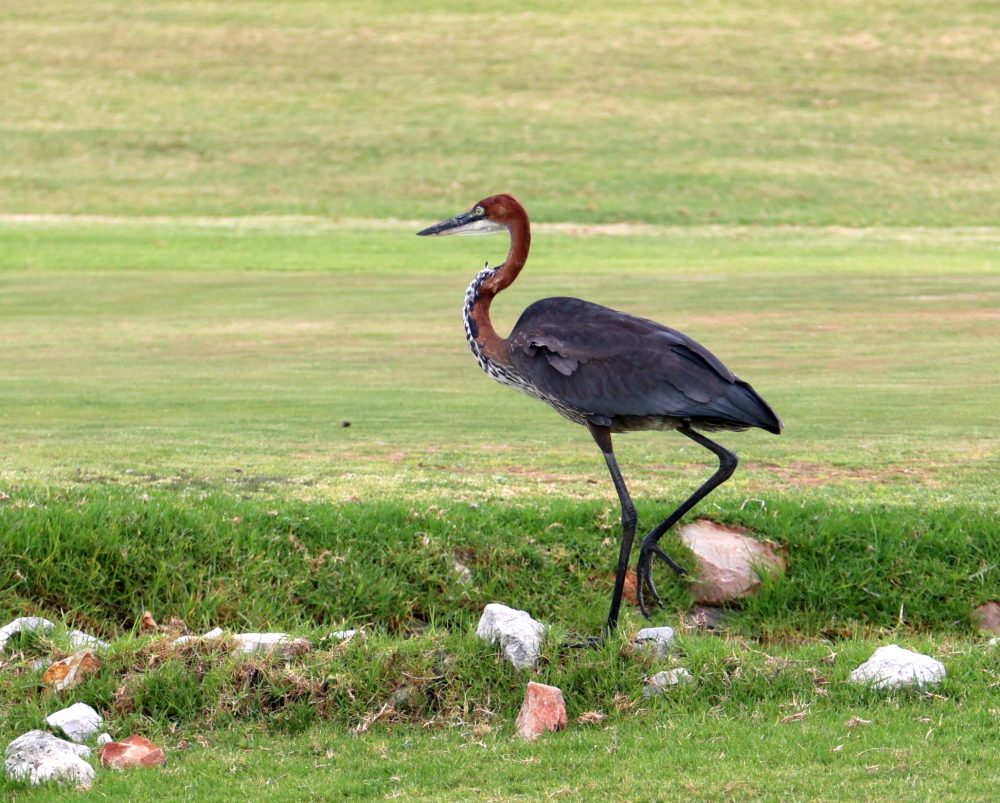The arrival of bird species previously not seen at Sardinia Bay Golf & Wildlife Estate was almost immediate when resident Ian Roberston seeded the ponds with indigenous tilapia a few years ago.
Grey and black-headed herons as well as malachite kingfishers found the tiny fish far too tempting to resist, much to the delight of Ian, wife Nina and other “twitchers” on the estate.
But even these passionate birders could hardly believe their eyes when a Goliath heron – the largest in the family – touched down at the tail-end of the 2024 festive season.
The magnificent bird, which can stand up to 130cm tall with a wingspan of four to six metres, usually keeps to the northern reaches of South Africa and large tracts of sub-Saharan Africa.
The Robertsons, the estate’s go-to bird experts, were contacted by fellow resident Mandi Campbell to inform them about the “big heron” near her home.

They rushed to the scene of the crime to snap photographs of the magnificent specimen dressed in its telltale slate grey and chestnut Sunday best.
It showed the full extent of its huge wingspan when it later took flight.
At the time, Ian believed they would never see it again. But it was back the very next day, suggesting that Sards was very much to its liking.
Ian says the twitcher community has noticed that a lot of birds are moving south.
“Take the long-crested eagle. Ten years ago, you never saw them further than East London.
“Fifteen years ago, they were not in the Eastern Cape at all. Now you see them here and in the Western Cape.”
He surmises that a lack of water and changing weather patterns are driving these birds southwards.
Goliath herons tend to gobble up everything from fish and frogs to rats. There is even a story of one catching a squirrel and drowning the luckless rodent before eating it.
Contact me please
The Robertsons are relative latecomers to birding, having only really begun taking it seriously in their retirement years.
They are now making up for lost time, undertaking trips to Ghana, Madagascar and Ethiopia to appease their appetite for feathered finds.
Ian has recorded 118 species at Sards alone, an impressive collection considering that there is record of 980 in southern Africa across the various watchlists.
While seldomly seen, Nina says the olive bushshrike can be heard in the bushier parts of the estate.
One year an entire opera of canaries decided to drop in, while cormorants continue to be drawn to the water in the ponds.
“When we first came here [eight years ago], we never saw anything, but then we started to see malachite kingfishers,” says Nina.
It is evident that different species favour different parts of the estate. Though some residents have never seen an African firefinch, they occasionally pop up at the Robertsons.
The 10 remaining homes in the final phase to be built at Sards are surrounded by thick bush and Ian believes there may even be species happily living there that they are unaware of.
From a bird’s perspective, the estate is prime property as 60 per cent of the 100-plus hectares will remain undeveloped.
This limits birds becoming habituated to people, allowing them to thrive as nature intended.
“We are just grateful for any special bird that arrives,” says Ian.
